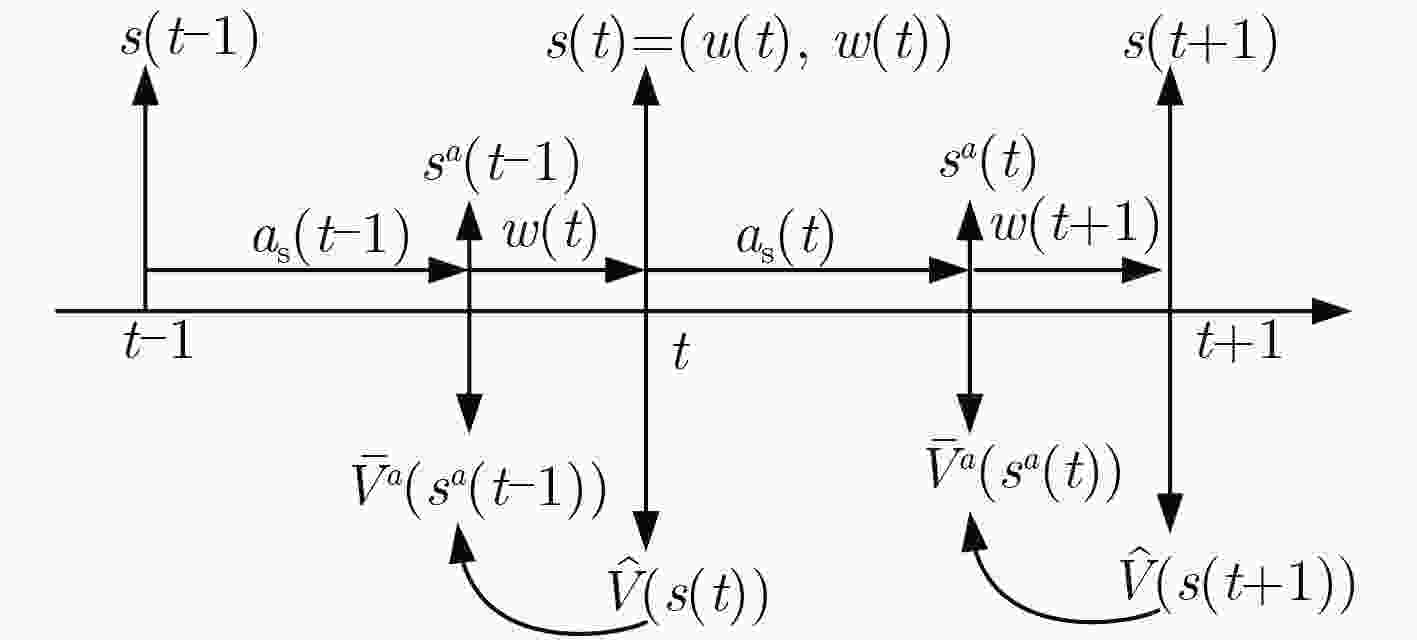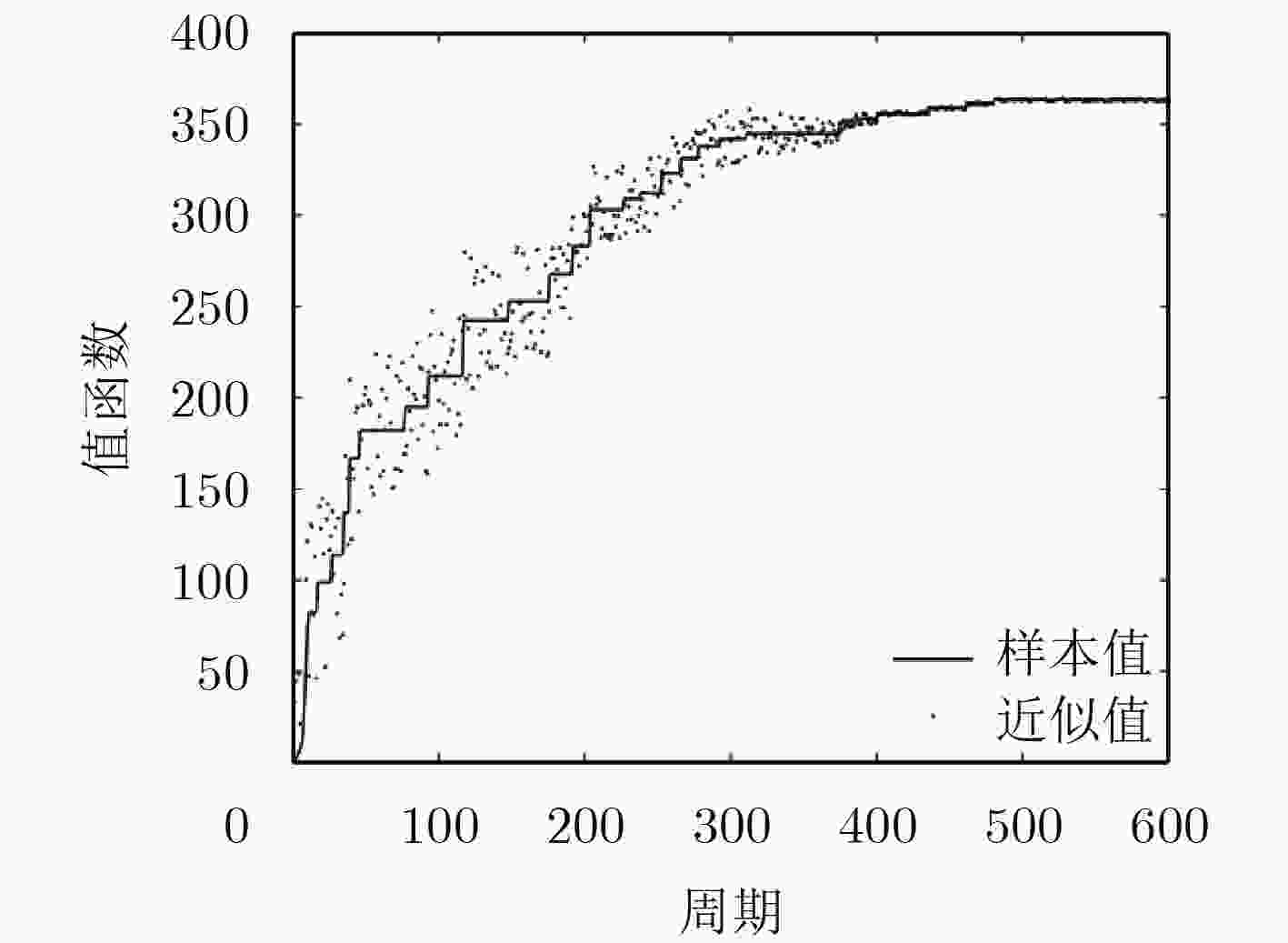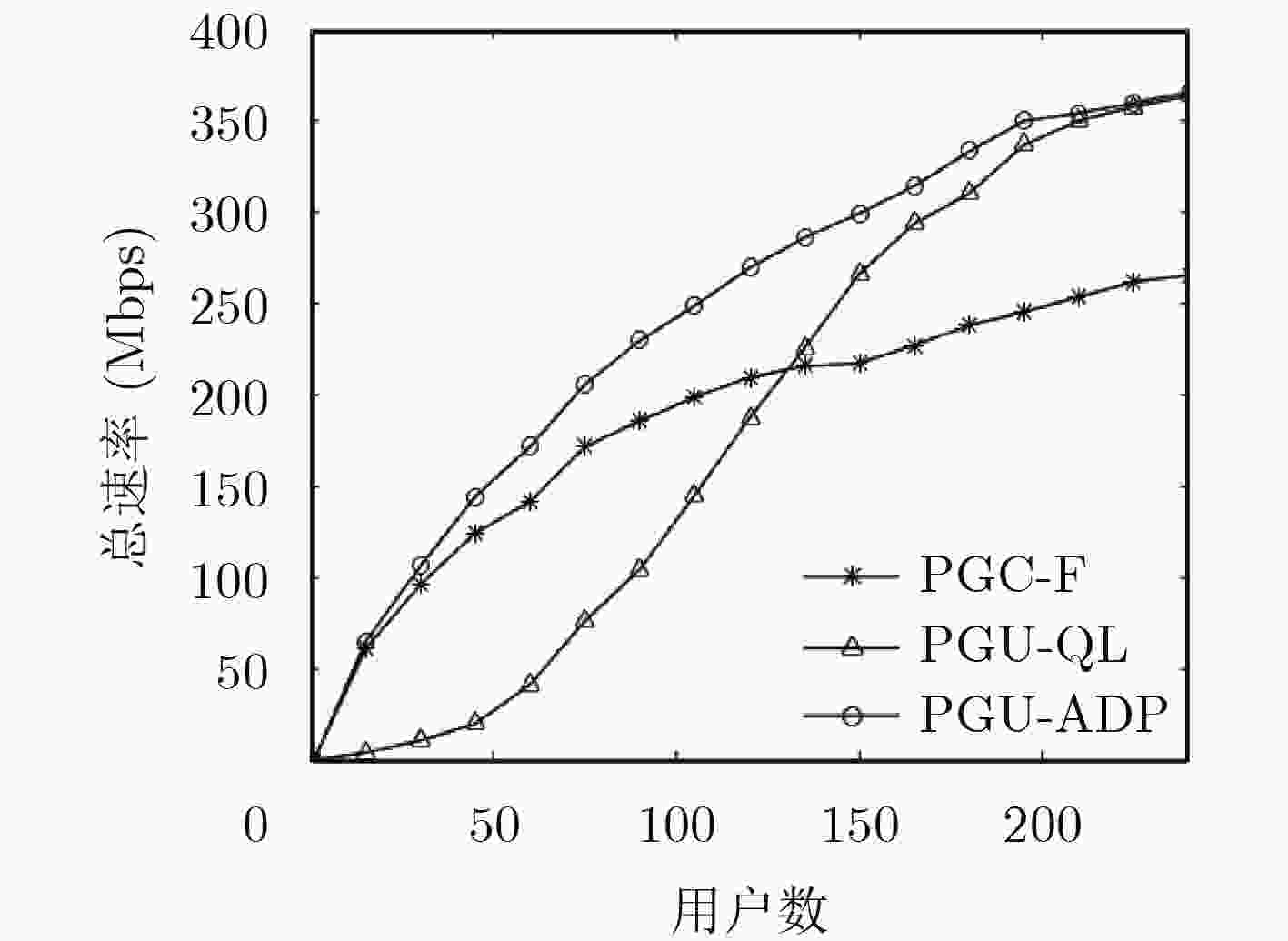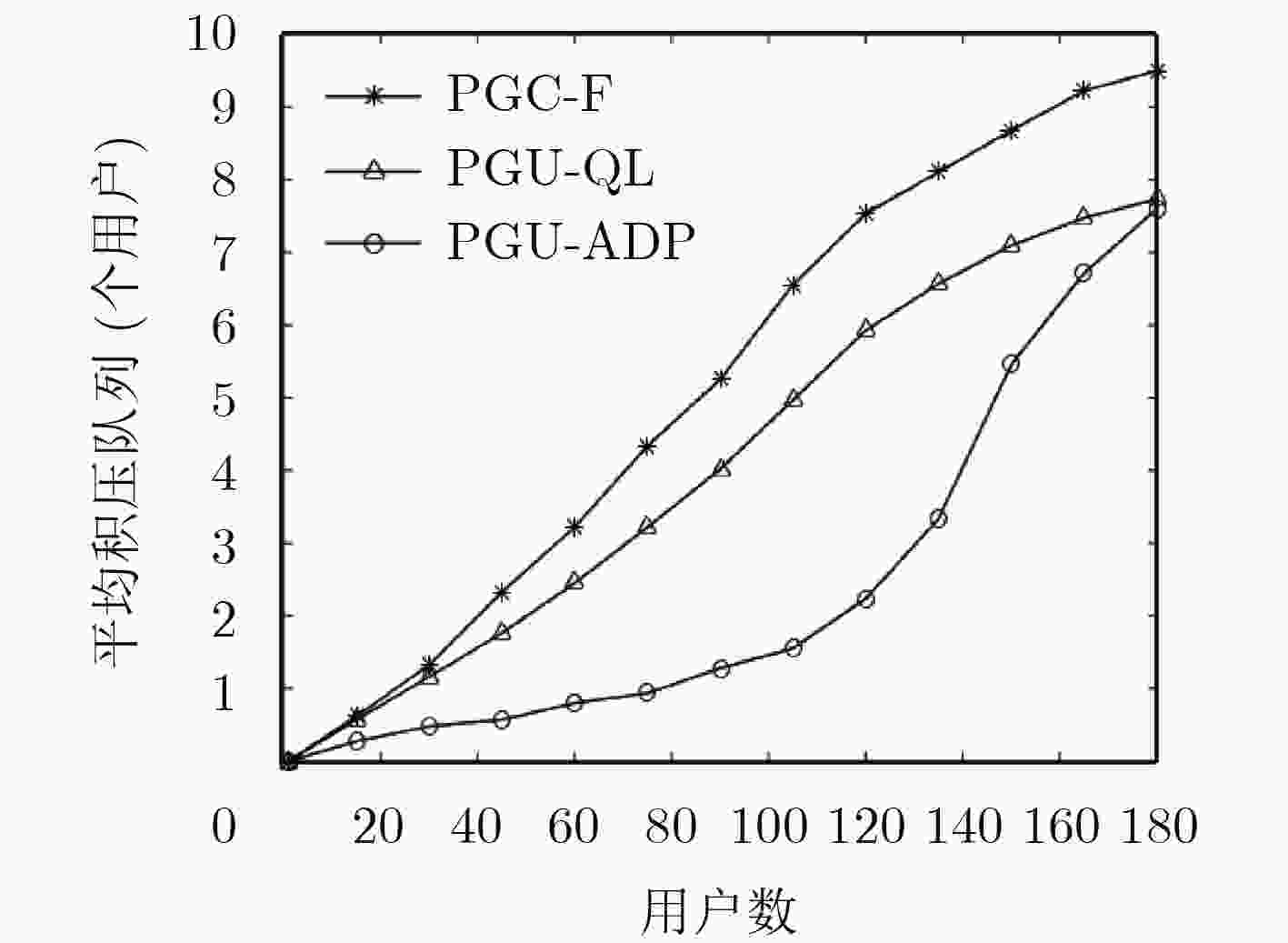Network Slice Virtual Resource Allocation Algorithm Based on Constrained Markov Decision Process in Non-orthogonal Multiple Access
-
摘要: 针对无线接入网络切片虚拟资源分配优化问题,该文提出基于受限马尔可夫决策过程(CMDP)的网络切片自适应虚拟资源分配算法。首先,该算法在非正交多址接入(NOMA)系统中以用户中断概率和切片队列积压为约束,切片的总速率作为回报,运用受限马尔可夫决策过程理论构建资源自适应问题的动态优化模型;其次定义后决策状态,规避最优值函数中的期望运算;进一步地,针对马尔科夫决策过程(MDP)的“维度灾难”问题,基于近似动态规划理论,定义关于分配行为的基函数,替代决策后状态空间,减少计算维度;最后设计了一种自适应虚拟资源分配算法,通过与外部环境的不断交互学习,动态调整资源分配策略,优化切片性能。仿真结果表明,该算法可以较好地提高系统的性能,满足切片的服务需求。
-
关键词:
- 5G网络切片 /
- 资源分配 /
- 受限马尔可夫决策过程 /
- 非正交多址接入
Abstract: An adaptive virtual resource allocation algorithm is proposed based on Constrained Markov Decision Process (CMDP) for wireless access network slice virtual resource allocation. First of all, this algorithm in the Non-Orthogonal Multiple Access (NOMA) system, uses the user outage probability and the slice queues as constraints, uses the total rate of slices as a reward to build a resource adaptive problem using the CMDP theory. Secondly, the post-decision state is defined to avoid the expectation operation in the optimal value function. Furthermore, aiming at the problem of " dimensionality disaster” of MDP, based on the approximate dynamic programming theory, a basis function for the assignment behavior is designed to replace the post-decision state space and to reduce the computational dimension. Finally, an adaptive virtual resource allocation algorithm is designed to optimize the slicing performance. The simulation results show that the algorithm can improve the performance of the system and meet the service requirements of slicing. -
表 1 基函数定义
基函数 描述 $P_{ln }^m(t) + {\alpha _{ln}}(t)$ 切片l 功率分配粒度 ${N_{ln }}(t) + {\beta _{ln }}(t)$ 切片l 的子载波数 ${(P_{ln }^m(t) + {\alpha _{ln }}(t))^2}$ 切片l 功率分配粒度平方 ${({N_{ln }}(t) + {\beta _{ln }}(t))^2}$ 切片l 的子载波数平方 $({N_{ln }}(t) + {\beta _{ln }}(t))(P_{ln }^m(t) + {\alpha _{ln }}(t))$ 切片l 中功率分配粒度与子载波数的乘积 表 2 基于近似动态规划的资源自适应算法
输入: ${\chi _h}\left( {{S^a}\left( t \right)} \right)$:基函数; $\gamma $:折扣因子; 输出: ${{η}}$:参数向量; ${\lambda _1}$, ${\lambda _2}$:拉格朗日因子; (1) while a new time period starts do (2) t← 0; ${{η}}$← 0; ${\lambda _1}$, ${\lambda _2}$← 0; //初始化 (3) for (t = 1; t <= T; t++) (4) while (5) while (6) 根据式(40)更新样本函数值 (7) if t>0 then (8) 根据式(39)更新参数向量 ${{η}}$ (9) End if (10) 采样外部随机变量w(t+1)的样本值 (11) 代入更新参数向量 ${{η}}$,根据式(35)更新决策后 状态的近似函数值 (12) end while (13) 根据式(34)代入最优策略行为计算目标函数 (14) 根据式(32)和式(33)更新 ${\lambda _1}$, ${\lambda _2}$ (15) end while (16) end for (17) end while 表 3 系统仿真参数
仿真参数 仿真值 子载波数 64 基站发射功率 33 dBm 路径损耗 133.6+35lg(d) 传输天线数 1 接收天线数 1 基站服务范围 500 m 单个子载波叠加用户数 1~4 (个) 分配行为:调整功率粒度 $\alpha = \{ {\rm{0}}{\rm{.25}},{\rm{0}}{\rm{.50}},{\rm{1.00}}\} $ 分配行为:调整子载波数 $\beta {\rm{ = 1}}$ 切片1需求 (5 ms, 200 kbit/s) 切片2需求 (10 ms, 500 kbit/s) 切片3需求 (50 ms, 1 Mbit/s) -
唐伦, 张亚, 梁荣, 等. 基于网络切片的网络效用最大化虚拟资源分配算法[J]. 电子与信息学报, 2017, 39(8): 1812–1818 doi: 10.11999/JEIT161322TANG Lun, ZHANG Ya, LIANG Rong, et al. Virtual resource allocation algorithm for network utility maximization based on network slicing[J]. Journal of Electronics&Information Technology, 2017, 39(8): 1812–1818 doi: 10.11999/JEIT161322 SALLENT O, PEREZ-ROMERO J, FERRUS R, et al. On radio access network slicing from a radio resource management perspective[J]. IEEE Wireless Communications, 2017, 24(5): 166–174 doi: 10.1109/MWC.2017.1600220WC PARSAEEFARD S, DAWADI R, DERAKHSHANI M, et al. Joint user-association and resource-allocation in virtualized wireless networks[J]. IEEE Access, 2016, 4: 2738–2750 doi: 10.1109/ACCESS.2016.2560218 BEGA D, GRAMAGLIA M, BANCHS A, et al. Optimising 5G infrastructure markets: The business of network slicing[C]. IEEE Conference on Computer Communications, Atlanta, USA, 2017: 1–9. AKPAKWU G A, SILVA B J, HANCKE G P, et al. A survey on 5G networks for the internet of things: Communication technologies and challenges[J]. IEEE Access, 2018, 6: 3619–3647 doi: 10.1109/ACCESS.2017.2779844 ZHANG Zihan, XIA Qinghong, YU Guanding, et al. Power control, user scheduling and resource allocation for downlink NOMA systems with imperfect channel state information[C]. 2017 9th International Conference on Wireless Communications and Signal Processing, Nanjing, China, 2017: 1–6. ZHU Jianyue, WANG Jiaheng, HUANG Yongming, et al. On optimal power allocation for downlink non-orthogonal multiple access systems[J]. IEEE Journal on Selected Areas in Communications, 2017, 35(12): 2744–2757 doi: 10.1109/JSAC.2017.2725618 FANG Fang, ZHANG Haijun, CHENG Julian, et al. Joint user scheduling and power allocation optimization for energy efficient NOMA systems with imperfect CSI[J]. IEEE Journal on Selected Areas in Communications, 2017, 35(12): 2874–2885 doi: 10.1109/JSAC.2017.2777672 DAWADI R, PARSAEEFARD S, DERAKHSHANI M, et al. Power-efficient resource allocation in NOMA virtualized wireless networks[C]. IEEE Global Communications Conference, Washington D.C., USA, 2016: 1–6. ZHANG Qi, ZHU Quanyan, ZHANI M F, et al. Dynamic service placement in geographically distributed clouds[C]. 2012 IEEE 32nd International Conference on Distributed Computing Systems, Macau, China, 2012: 526–535. ISLAM S M R, AVAZOV N, DOBRE O A, et al. Power-domain Non-Orthogonal Multiple Access (NOMA) in 5G systems: potentials and challenges[J]. IEEE Communications Surveys&Tutorials, 2017, 19(2): 721–742 doi: 10.1109/COMST.2016.2621116 CHEN Tianyi, MOKHTARI A, WANG Xin, et al. Stochastic averaging for constrained optimization with application to online resource allocation[J]. IEEE Transactions on Signal Processing, 2017, 65(12): 3078–3093 doi: 10.1109/TSP.2017.2679690 POWELL W B. Approximate Dynamic Programming: Solving the Curses of Dimensionality[M]. NJ, Princeton: Wiley, 2007: 129–144. FANG Fang, ZHANG Haijun, CHENG Julian, et al. Energy-efficient resource scheduling for NOMA systems with imperfect channel state information[C]. IEEE International Conference on Communications, Paris, France, 2017: 1–5. RAI R, ZHU H, and WANG Jiangzhou. Resource scheduling in Non-Orthogonal Multiple Access (NOMA) based cloud-RAN systems[C]. 2017 IEEE 8th Annual Ubiquitous Computing, Electronics and Mobile Communication Conference (UEMCON), New York City, USA, 2017: 418–422. -






 下载:
下载:








 下载:
下载:
